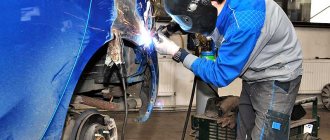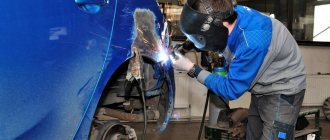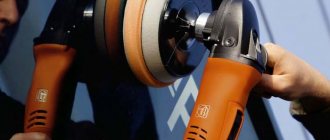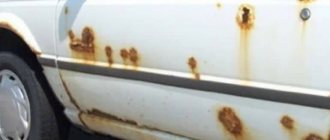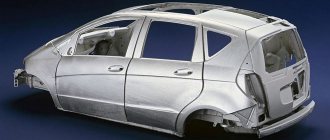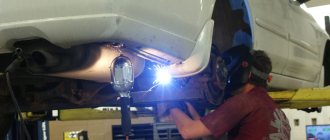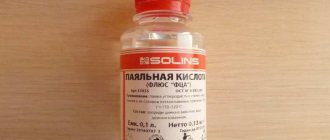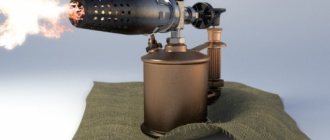The main function of any sealant is to insulate and seal various joints and surfaces. When repairing a car body, such products are indispensable: they help glue parts together and reliably protect the seams from moisture and dirt.
Most often, when doing body work, a seam sealant is used that has suitable technical characteristics and a convenient release form.
Sealant selection criteria
Automotive stores sell a variety of sealants: for hatches, bodies, and pipe connections. They differ in terms of heat resistance, elasticity, and service life. The highest quality, but most expensive, are professional products, which are sold in large containers and are usually used in auto repair shops.
For home use, sealants are purchased in tubes of suitable volume (40-200 g). If you decide to give preference to the latter option, it is better to purchase the material in an aluminum tube: it fully retains its properties throughout its shelf life. Cheaper products are presented in plastic tubes, but when purchasing, be sure to check the remaining shelf life: it should be at least 6 months.
Some sealants have a convenient dispenser tip: they can be easily applied even to surfaces in hard-to-reach areas. Body sealant in a cartridge requires the additional purchase of a glue gun, without which you will not be able to use the product.
Cleaning the weld
The car body is its most expensive part. As long as the skeleton of a vehicle is alive, so long is its service life. All damage to the car body can be divided into the following types:
- Destruction by corrosion;
- Surface damage due to mechanical damage (including road accidents).
Each type of repair work has its own methodology. To combat corrosion, all kinds of primers are used, which reliably protect the metal from further destruction.
Mechanical damage and defects are most often welded. At this stage of repair work, cleaning the weld seam plays a key role in controlling the quality of the operations performed. Ideally, the junction of the parts should be inconspicuous and not attract attention.
Welding methods and equipment used
If the surface of the body is heavily corroded, welding is also used for repairs. The equipment that a master chooses to perform welding work can have different performance levels and ultimately determines the quality of the seam. Welding used in body repair can be of several types:
- Gas;
- Electric arc;
- Manual semi-automatic electric arc (environment with protective gas);
- Contact point.
Hobbyists repair their hardware using gas welding; this is the most affordable equipment for private use. Hand tools are not helpful in this matter, as the operation becomes very labor-intensive. Professional welders are skeptical about the use of manual electric arc welding, what about amateurs? Resistance welding is an expensive tool used by skilled craftsmen.
Types of seam sealants
Any joint sealant for cars has a reliable composition, otherwise it will not be able to provide the proper level of sealing of the joints. And yet the materials are not the same in their basis, therefore they differ in properties and characteristics.
Acrylic based mixtures
Acrylic sealants are prepared on the basis of polymer compositions. They have good adhesion to the surface, but under strong vibration or shock loads they can peel off due to their average elasticity. It is best to use such products for porous materials and stable joints and seams. Any sealants with acrylic can be painted or varnished.
Anaerobic sealants
Such products are easy to distinguish from others: they have a liquid texture, which is why they are called “liquid pads”. The sealant is distributed inside cavities and the smallest cracks, and hardens only after contact with oxygen ceases. Typically, anaerobic compounds are used to repair small areas, otherwise there is a risk of insufficiently strong seams. Most often, the compositions are used by professionals, because they must be applied correctly and strictly follow the instructions.
Silicone sealants
They are considered the best option for home repairs of metal products. Such sealants are easy to apply, harden quickly, and retain strength and elasticity for a long time. Silicone is impermeable to moisture even at high pressure and is not afraid of temperature changes. With significant air humidity, it hardens very quickly - in 10-15 minutes. Typically, products are applied from a tube with a long nozzle. They can fill irregularities up to 6 mm deep.
Polyurethane compounds
These sealants are the most popular on the market and are available in a huge range. They can be sprayed or paste-like for brush application. Distinctive features of polyurethane sealants are:
- ease of use,
- no spreading from vertical bases,
- high flexibility, elasticity, heat resistance, moisture resistance,
- withstand large mechanical loads.
Bitumen mixtures
Presented in the form of compositions based on bitumen with the addition of modifiers, fillers, and adhesion accelerators. They look like a dark paste. They do not require careful surface preparation and are suitable for most materials, including any metals. Can be used in damp environments and tolerate direct contact with water.
FANCLUB-VW-BUS.RU
VW minibus fan club
- Unanswered topics
- Active topics
- Search
- our team
What is the technology for processing weld seams?
What is the technology for processing weld seams?
Posted by allann » 12 Oct 2012, 09:37
Hello. Maybe this has already been discussed, but I didn’t find this in the topics. If you can, stay on topic. You don’t need to watch the whole video, but only from the 9th minute.
https://youtu.be/
After welding and cleaning, it seems to be coated with zinc. What does he apply before galvanizing? What kind of zinc? What does he stick the spatula into later when he smooths out the zinc snot?
If anyone has encountered this method, can you please share the information? Is it worth using this method or can it be simpler. It is necessary to process several areas of the body where the pieces are welded. Thank you
Re: What kind of technology for processing weld seams?
Post by ksenon17 » 12 Oct 2012, 09:43
Re: What kind of technology for processing weld seams?
Post by Yurgen » Oct 12, 2012, 10:20 am
Re: What kind of technology for processing weld seams?
Post by Mikhail Cossack » Oct 12, 2012, 10:29 am
Re: What kind of technology for processing weld seams?
Post by vfrc » 12 Oct 2012, 11:23
Re: What kind of technology for processing weld seams?
Post by Mikhail Cossack » 12 Oct 2012, 13:26
Re: What kind of technology for processing weld seams?
Post by Dimon » Oct 12, 2012, 01:47 pm
Also how it is used, how the cardon was opened, so this duck went to the people that the Germans galvanized right up to the roof
And by the way, under the rubber band of my windshield there is tin and it’s holding, and I don’t remember whether the rear time was pressing, in general it was just primer with paint, and after seven years the rust began to come out.
Re: What kind of technology for processing weld seams?
Post by Mikhail Cossack » 12 Oct 2012, 17:11
Re: What kind of technology for processing weld seams?
Posted by allann » 12 Oct 2012, 18:44
Re: What kind of technology for processing weld seams?
Post by vfrc » 12 Oct 2012, 19:19
Re: What kind of technology for processing weld seams?
Post by Mikhail Cossack » 12 Oct 2012, 19:57
Re: What kind of technology for processing weld seams?
Post by ksenon17 » 12 Oct 2012, 20:00
Re: What kind of technology for processing weld seams?
Posted by allann » 12 Oct 2012, 21:41
electrochemical is probably galvanization, but in May cases it is impossible. This is what the German smears with before applying. I don’t even really understand where to get such zinc rods (if there is zinc at all), but it seems that it gets into the gaps, plus it won’t bounce off like putty where it will be thicker (after welding the pieces, you need to level them in a thicker layer).
Types of body sealants by application method
You can determine exactly how the sealant is applied by its texture and type of packaging. Also, the application method is always indicated in the instructions for use of the composition.
Sprayable moisture-curing sealant
Typically, such products are based on modern polymers. The compositions are one-component, contain a large amount of dry substances, therefore they quickly harden in air under the influence of humidity and form a very durable seam. Sprayable sealants are applied with a special spray gun. It is especially convenient to work with them in the area of the underbody, engine compartment, and trunk of a car.
Brush sealant
Such compositions are made on the basis of silicone and nitro rubber; they are sold in cans of 1 kg or larger. Sealants can be used to seal joining and weld seams, glue jumpers, flavors, pallets, seal the trunk, wheel arches. Usually the products are available in white, gray, black colors. They are applied with a brush, dry in literally 10 minutes and can be painted immediately.
Sealant tape
Applying sealant to a car often requires a lot of skill, otherwise the seam will not be perfectly smooth. If you don’t have confidence in your own skills, use tape, which is very easy to use. Tape sealant does not need to be lubricated with glue - it already has an adhesive base. Flexibility allows the material to be used in any location during body repairs. Immediately after gluing, the tape can be painted - it does not require drying.
Extruded sealants
Such compositions are sold in tubes and cartridges. To seal joints, seams, the material must be squeezed onto the parts to be joined manually or using a gun. The seam will be most uniform when using an air gun. Typically, such products are used to seal the seams of the hood, the inside of the doors, the engine compartment, and the trunk.
Moskvich 2141 BTR-2, Vozrozhdenie › Logbook › Day 36. Guide to protecting welds
For the last stage of welding work (welding the false thresholds from the inside of the cabin), it is necessary to process the half-threshold joint that will be forever closed by the cavity of the false threshold.
Therefore, instructions on how to protect welding seams according to science
We see a seam from a week ago.
Therefore, I use a brush attachment on a grinder and clean off all the oxide. Then I blow the seam with a vacuum cleaner (hose on the exhaust). It's faster than dragging the blower from the compressor)
I blow it again until the solvent dries and cover it with reactive (tapping) primer. I blew it out with a paint spray, although you can use a brush (but it will take up much more soil)
Then I heat the hand (suture) sealant in a water bath. We use a good one, dear. The cheap one will fall off in 4-5 years like a factory one from Moscow. Then I apply it to the seam with a brush.
It turns out like this:
Next you need to dry it, follow the instructions for drying time. It's cold in my garage, so I leave it to dry overnight.
In the morning you need to cover the resulting
After this procedure, processing of the weld seam is completed. The seam becomes almost eternal and will last the entire service life of the car.
Moskvich 2141 1992, petrol engine 1.5 l., 72 l. p., front drive, manual transmission — body repair
Cars for sale
Moskvich 2141, 1990
Moskvich 2141, 1998
Moskvich 2141, 1993
Moskvich 2141, 1997
Comments 51
Well, how is the seam doing after 6 years?)
Why is epoxy primer applied over joint compound and not vice versa?
I have the same question :)
So, how are the stitches holding up after 4 years?)
I support it, it’s also interesting!
In Steam Punk style)
PLEASE TELL ME, THE FRONT SIDE NEEDS TO BE WELDED... ACCORDING TO THE IDEA THERE WILL BE NO SEALANT, THERE WILL BE A WHOLE SEAM (WELDING THE ARCH) WHAT IS THE BETTER PROTECTION? ALL I FOUND WAS PASTE WITH TIN FOR TINNING. THEY Suggest THAT YOU CAN PROCESS A PASTE FOR SOLDERING FOOD PIPES, IT'S WITH SILVER... I WANT THE SEAM NOT TO RUST ANYMORE... IS THIS POSSIBLE?
it won’t even work with a spatula if you protect the cooked food from the inside from moisture and air
As I understand it, if the metal is tinned on all sides and closed, then everything will be fine?
the weld seam is where the threshold (stiffening rib) is, if it suddenly gets jammed, is it worth bothering with repairs or is it easier to treat with chemicals?
success and not a nail or a rod!
Tell me, what did you use to treat the external welds?
Popular Products
To choose a good automotive seam sealant, you should pay attention to the most famous and high-quality products on the market.
Merbenit XS55
It is a high-strength sealant for the hood, underbody and other parts of the body on a modified silicon base. It has enormous tensile strength (4 N/sq. mm), excellent adhesion to metal and plastic. In addition to sealing seams, it can be used when installing climate control equipment and ventilation. In factory conditions it is used in the automotive industry, carriage building, and in the production of polymers. The advantages of the sealant are undoubted:
- perfect filling of even the smallest cracks,
- possibility of painting the finished seam,
- absence of harmful solvents and unpleasant odors,
- resistance to water, salt, oils, alkali and acid solutions,
- tolerance to vibration, shock, atmospheric influences.
BODY 999
Body 999 sealant can be found at any automotive store. It is considered one of the most common and is sold in 150 ml tubes, 300 ml cartridges, and 1000 ml cans. A polyurethane-based product is used to fill voids and treat machine welds to protect against water and the harmful effects of atmospheric factors. The sealant is great for metal, plastic, and painted surfaces, but it should not be applied to areas exposed to ultraviolet radiation.
The advantages of the material are:
- maintains elasticity for a long time,
- does not shrink
- does not flow on vertical surfaces,
- can be applied even in a thick layer and not crack,
- has a high degree of adhesion to surfaces,
- ready to use, does not require dilution,
- Can be painted after drying.
3M 08537
3M automotive seam sealant is also made on the basis of polyurethane. This is a one-component composition, available in black and white, considered universal and suitable for:
- panel connections,
- sealing weld seams,
- processing of arches, thresholds, doors,
- sealing the bottom, joints inside the trunk,
- shock absorber mountings,
- strengthening bolted connections.
The product has a brush application method, is liquid and is available in metal cans. It is resistant to oils and petrochemicals, highly elastic, not afraid of water, does not shrink, maintaining its structure for several years, and dries quickly. After final polymerization, the seam will be hard, but quite elastic. 50 minutes after application it can already be painted with any paint.
Terostat 9320
Teroson line sealant Terostat 9320 is considered a universal “4 in 1” product. This is a sprayable one-component composition based on modern modified polymers, which hardens under the influence of moisture from the air. It comes in black, gray and ocher colors.
After polymerization, the Terostat adhesive-sealant forms an elastic, abrasion-resistant seam, which in appearance will not differ from the factory one. The material has a high degree of adhesion to metals, is compatible with any paints, primers and primers, is resistant to UV radiation, shrinkage, sagging, aging, and hardens quickly in air.
Novol Gravit 630
Novol Gravit 630 sealant is a one-component polyurethane product used for sealing welded joints and soldered areas. It creates an elastic and very durable shell that does not shrink, crack, or wrinkle over time. Novol sealant has good adhesion to metal, as well as to varnished sheet metal. The finished seam can be coated with acrylic paints. The product is applied with a special gun. Its only drawback is its low resistance to ultraviolet radiation.
Reoflex Brush Sealant
Reoflex brand brush sealant is designed for sealing any seams on metal, concrete, wood, and is widely used in body repair. It has high anti-corrosion and sound-proofing properties, is easy to apply and dries quickly. After polymerization, the sealant forms an elastic seam, externally close to the factory one.
Bool
Bool brand polyurethane adhesive-sealant is available in cartridges for a 310 ml gun. It is widely used to strengthen seams between sunroofs, headlight holders, metal parts, and gutters. The finished seam can be painted with all types of varnishes. The product is sold in white, beige, black colors.
APP PU50
This material is one-component, made on the basis of polyurethane. APP has a high degree of adhesion to primed and painted metal, stainless steel, glass, all types of plastic, concrete and aluminum. In body repair it is used to seal welded joints. The method of application of the material is special: you must first put it on the seam in the form of a roller, then spread it with a spatula or brush.
Body treatment after welding
» Articles » Body processing after welding
So this and the previous post were written late because I was on vacation
3 days after welding, I flew to treat the bottom and hidden cavities!
stocked up
2 bottles of bitumen rubber treatment and 2 bottles of Movil
I scrubbed the entire floor in the cabin with a brush
And flew off for processing
As always, my work began with dismantling the car) there were cracks in the roof and it was decided to weld them and strengthen them with iron from the inside
removed the 3rd door, cleaned the cracks, scalded them, scalded them from the inside
I came to work as usual to my friend Alexander santei-2110 and had to kick out his monster
17th sneakers and sketches of new arches (more details in his BZ he has already come a long way)
Lambo hinges as they are!
(if you need it we can make it to order!)
grinded the weld
put the door in place and treated it with Movilya
then Alexander began to process my car inside and out
The stench was terrible for about 5 days, I had to leave the windows open
I also had a trip of 800 km ahead of me on the front brakes alone, so I decided to change the pads that I had installed a YEAR ago, ferodo red pads
to put old pads on the edges from one wheel in the middle, new ones! I think that over the course of a year they have worn off very little! ! !
(I brake a lot and sometimes even at 140 I have to brake!)
these are my 2 helpers in pushing the piston back)
(one of them always travels with me just in case) ) )
Soon I’ll tell you about a trip of 800 - 1100 km on my basin with bolts
www.drive2.ru
How to use sealant correctly
The application of auto sealants has its own nuances, and to obtain a high-quality result, the following rules must be strictly followed:
- Before work, thoroughly clean the surface, remove rust, degrease,
- To enhance adhesion, clean the substrate with red Scotch Brite,
- carry out priming with special primers for metal, if this measure is indicated in the instructions for the sealant.
To seal the seams, you need to prepare the composition: if necessary, dilute or print the tube, insert the cartridge into the gun, open the package with tape. You may also need a spatula or brush for the job. Afterwards, you need to apply the composition to the area of the future seam, acting at the same speed along its entire length - this will help make the joint smooth, like a factory one.
Excess sealant should be removed immediately with a spatula or your fingers. If the composition is very sticky, you can sprinkle it with a little water. In the future, it is allowed to paint the seam, but only after the time specified by the manufacturer has elapsed. This usually becomes possible after the sealant has completely polymerized.
Causes of corrosion on a car
All vehicles without exception are subject to this, regardless of which manufacturer they were produced by. To a lesser extent, it affects cars produced in a single copy on a personal order. As a rule, they are subjected to anti-corrosion treatment at the first stages of production. But even such measures are not able to completely rid the vehicle of this harmful phenomenon. With further operation of the car, especially in large cities and metropolitan areas, the process of destruction of metal by rust receives favorable conditions for its development. The acceleration of corrosion is facilitated by small scratches and chips that a car can receive when driving on a poor quality road.
How to properly remove sealant
If the composition is applied incorrectly or if there is old sealant, the seam must be removed and the work done again. To clean hidden seams, use a mechanical method - remove a layer of material with a sharp spatula, knife, pumice stone, or sandpaper. To make sure you don’t scratch the base, you can use a chemical method - moisten the sealant with white spirit, and then use a knife to separate the softened compound. After preparing the base, you can apply a new layer of sealant, following the manufacturer's instructions.
Do-it-yourself anti-corrosion treatment of a car is considered complete
Of course, the work done will not give you a guarantee that doing this procedure just once will be enough. The coating will deteriorate over time and there will be a need to apply a new one. But carefully applied mastic will protect your car from corrosion for a long time. The service life of the anti-corrosion mixture will depend on many conditions, including the quality of the mixture used, compliance with the technological processes for its application, the initial condition of the car and its operating conditions.
The urgency of carrying out work to protect your car is explained by the speed of the process of destruction of metal by rust, which is facilitated by the increased humidity of air masses in certain regions and the use of chemical reagents on urban roads. Nowadays, even when buying a car at a prestigious dealership, experts recommend treating the body with an anti-corrosive agent. This is due to the fact that not all manufacturers pay due attention to this important issue. And car owners have to do the treatment themselves or at a car service center. However, not everyone can afford to entrust this work to service technicians, because this is a rather expensive procedure, and, again, no one can vouch for the quality.
Tools and materials
To weld the bottom, in addition to welding equipment, you will need consumables. When choosing which metal to cook with, you need to consider two points:
- thin steel is more difficult to weld; experience is needed to choose a temperature regime that eliminates the risk of burns;
- Thick iron is more difficult to process.
The patches are made of metal with a thickness of 1 to 2 mm - these are the optimal parameters.
What you will need when working:
- welding machine, when working with manual arc welding you will need thin electrodes, maximum size 1.6 mm; for a semi-automatic machine you need copper wire and carbon dioxide;
- grinder with cutting and grinding attachments;
- gas welding plus carbide, oxygen for cleaning rust from hard-to-reach places;
- regular or electric metal shears, they are used to cut out patches;
- electric drill;
- a hammer, used to tap the bottom of the car to identify defects;
- a chisel or hammer drill to remove sound insulation;
- screwdriver or screwdriver.
The bottom is viewed on an overpass or in an inspection hole in good lighting. The metal is tapped with a hammer to test its strength. A lift will be needed to provide access to the damaged areas.
You will need a rust converter, soundproofing coatings; anti-corrosion compounds; primer for metal; solvent or other degreasing compound.
Unexpected expenses
It is necessary to provide for the purchase of spare parts. Their necessity is determined after inspecting the car. During repair work, dilapidated elements of the machine are replaced:
- rotten and bent sills, they are removed first, and during installation they control the geometry of the body;
- floor spars;
- floor panels, they are mounted from below;
- brake and fuel pipes stuck to the metal.
Sometimes other elements of the machine require replacement. It is better not to purchase spare parts for future use; they may not be needed.
Preparatory work
When the iron is rotten in several places, it is easier to digest the entire bottom. In some cases, replacement is more profitable than installing a large number of metal patches. Repairing the underbody of a car with your own hands begins with the preparatory stage. Areas with large defects are cut out, small ones - just cleaned of rust. When it is difficult to reach with a grinding wheel mounted on an angle grinder, turn on gas welding.
The seam areas on the machine and patches are coated with a rust converter, then cleaned to a shine. After this it is degreased. The patches are adjusted to the bottom configuration using heat, the metal is easier to deform, or special bending devices.
Useful tips
To repair the underbody of a car with your own hands, experts recommend using semi-automatic machines. The additive is supplied at a fixed speed, the burner provides uniform heating. The seam is of high quality and even. When working with electrodes, an inverter with additional functions that support constant operation is convenient. They reduce the risk of electrode sticking.
Before cutting a sheet of metal, the exact dimensions of the defect zone are determined. The patch must be suitable in size and adhere to the geometry. To deform, the sheet is not heated for a long time - the strength characteristics of the alloys decrease and they become friable. Movements of the hand with the holder or attachment should be uniform, without jerking. Large sections are connected with a continuous seam, leaving gaps of up to 3 cm. Such connections better withstand dynamic loads and increase the strength parameters of the body. Such connections require a durable insulating coating. Mastic prevents moisture from getting into microscopic gaps.
How to treat hidden cavities
All products for hidden cavities have several important properties in common:
- penetrating ability, the compositions have special fluidity and surface tension forces;
- wettability in relation to all types of factory coatings;
- adhesion, that is, sticking to prevent oxygen and moisture from entering the protected parts;
- the ability to remain after conditional drying in a semi-rigid state so as not to crack and continue to stick to parts;
- content of corrosion inhibitors.
When choosing a specific product, you should carefully read all available ones.
The cheapest option is “Working out”
In ancient times, it was customary to close the ventilation holes and pour used transmission or engine oil into the sills. Under no circumstances should you do this now.
Oil does not protect against anything, but it perfectly promotes the peeling of existing coatings and the development of under-film corrosion, after which through holes suddenly form in the metal.
Movil and Pussalo
Movil is a product of Soviet design and has not been produced for a long time. What is now sold under this name has nothing to do with the then popular product and cannot be recommended for the protection of thresholds. The very fact of using someone else's brand says a lot.
Pussalo is a petroleum-based product, suitable for preserving metal parts, but also not suitable for thresholds. But it will be almost impossible to clean damaged cavities.
Modern anti-corrosion agents
Many formulations of varying quality are sold specifically for application into hidden cavities. You need to focus on the manufacturer’s fame and positive reviews.
The selection conditions are traditional - a reputable manufacturing company, not the lowest price, a reliable supplier and the direction of action of the product indicated in all documents and on the company’s website. Selecting a specific cylinder will not be difficult, and the protection properties are given above.
